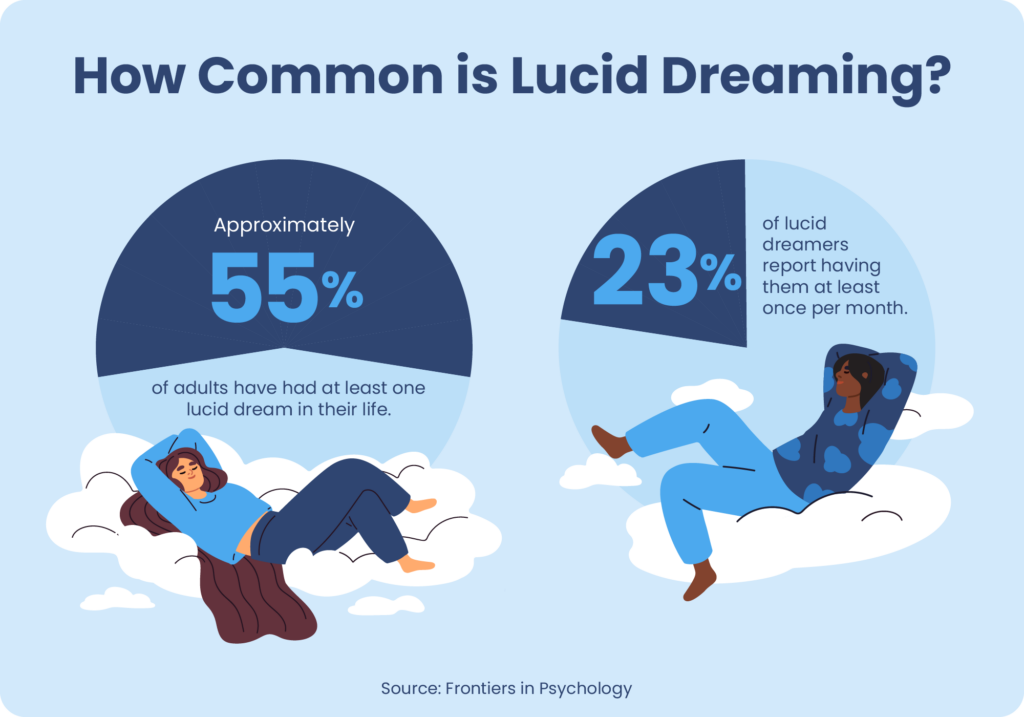Welcome to the world of lucid dreaming, a fascinating phenomenon that allows you to become aware and conscious within your dreams. In this beginner’s guide, we will explore the secrets of lucid dreaming, the science behind it, and practical techniques to experience this extraordinary state of consciousness.
Definition and Overview of Lucid Dreaming
Lucid dreaming occurs when you are dreaming and become aware that you are dreaming while the dream is still ongoing. This awareness grants you the ability to actively participate in and manipulate the dream’s content. It’s like having a vivid, immersive experience in a world of your own creation. Lucid dreams can range from surreal adventures to realistic simulations of everyday life, making the experience both intriguing and empowering.
The Fascination of Lucid Dreaming
The allure of lucid dreaming lies in the limitless possibilities it offers. You can fly through the skies, meet your favorite celebrities, or explore ancient civilizations – all within the boundaries of your mind. It’s a playground where you are the architect of your imagination, free from the constraints of the waking world.
Benefits and Potential Applications
Beyond the sheer excitement of lucid dreaming, there are numerous potential benefits and applications:
- Enhanced creativity and problem-solving skills.
- Overcoming fears and recurring nightmares through confrontations and resolution.
- Improved emotional healing and therapy by interacting with the dream’s symbolic representations.
- Opportunity to practice and improve real-life skills, such as public speaking or sports.
- Increased self-awareness and mindfulness in daily life.
Understanding the Science of Dreams
The Basics of Sleep and Dream Cycles

Before delving into lucid dreaming, it’s essential to understand the basics of sleep and dream cycles. Our sleep is divided into Rapid Eye Movement (REM) and Non-Rapid Eye Movement (NREM) stages. Dreams primarily occur during the REM stage, which accounts for around 20-25% of our sleep cycle. During REM sleep, brain activity is remarkably similar to that of wakefulness, leading to vivid dream experiences.
Theories and Mechanisms of Dreaming
Despite decades of research, the exact purpose and mechanisms of dreaming remain a subject of debate among scientists and psychologists. Some theories suggest that dreaming serves as a form of memory consolidation, emotional regulation, or problem-solving process. Lucid dreaming, in particular, is associated with increased activity in the prefrontal cortex, the area responsible for decision-making and self-awareness.
The Lucid Dreaming Phenomenon
Lucid dreaming is not a new discovery; cultures throughout history have explored and practiced it in various forms. In recent times, lucid dreaming gained popularity due to the works of researchers and authors like Stephen LaBerge and Carlos Castaneda. The phenomenon has since captured the interest of both scientific communities and curious individuals seeking to unlock the mysteries of the mind.
The Step-by-Step Guide to Lucid Dreaming
Preparing Yourself Mentally
Mental preparation is crucial for entering the world of lucid dreaming:
- Keeping a Dream Journal: Start by recording your dreams as soon as you wake up. This practice enhances dream recall and helps you identify dream patterns and themes.
- Reality Checks and Awareness Techniques: Throughout the day, perform reality checks, such as trying to read text or pushing your finger through your palm. This habit will carry over into your dreams, triggering lucidity when reality checks fail.
- Affirmations and Visualizations: Before sleep, repeat affirmations like “I will become lucid in my dreams” and visualize yourself recognizing that you are dreaming.
Creating the Ideal Sleep Environment
To improve your chances of having lucid dreams, create a sleep-conducive environment:
- Sleep Hygiene and Routine: Stick to a consistent sleep schedule and create a relaxing bedtime routine to signal your body that it’s time to rest.
- Enhancing Dream Recall: Place a notepad and pen near your bed to jot down dream memories as soon as you wake up, reinforcing dream recall.
Practicing Lucid Dream Induction Techniques
Several effective techniques can induce lucid dreams:
- MILD (Mnemonic Induction of Lucid Dreams): Before falling asleep, repeat a mantra, such as “I will recognize I’m dreaming” to program your subconscious for lucidity.
- WILD (Wake-Initiated Lucid Dreams): This technique involves transitioning directly from wakefulness to a lucid dream while maintaining consciousness during the process.
- WBTB (Wake-Back-to-Bed) Technique: Wake up after 4-6 hours of sleep, stay awake for a short period, then go back to bed while maintaining awareness to enter a lucid dream state.
Navigating the Lucid Dreaming Experience
Gaining Control in a Lucid Dream
Once you achieve lucidity, it’s time to explore and gain control:
- Stabilization Techniques: Rub your hands together or focus on your breathing to stabilize the dream and prevent it from fading.
- Interacting with the Dream Environment: Engage with the dream by talking to dream characters or experimenting with your surroundings.
Overcoming Challenges and Fears
Lucid dreaming can be a profound and sometimes challenging experience:
- Dealing with Nightmares: Confront your fears head-on and transform nightmares into empowering experiences.
- Managing Lucid Dreaming Excitement: The excitement of lucidity may wake you up initially, but with practice, you can learn to stay calm and composed within the dream.
Utilizing Lucid Dreams for Personal Growth
Beyond the thrill of exploration, lucid dreams offer opportunities for personal development:
- Emotional Healing and Therapy: Engage with dream elements symbolically to process and heal emotional wounds.
- Enhancing Creativity and Problem-Solving: Seek creative solutions to real-life challenges by exploring the dream world.
Advanced Techniques and Practices
Dream Yoga and Meditation
Inspired by Tibetan Buddhist practices, dream yoga involves cultivating mindfulness and awareness within dreams to attain spiritual insights and awakening. Meditation in lucid dreams can lead to profound experiences and a deeper understanding of the self.
Astral Projection and Out-of-Body Experiences
Some lucid dreamers report experiences of astral projection or out-of-body experiences (OBEs). These involve the sensation of leaving the physical body and exploring the world beyond it, sometimes with a sense of floating or flying.
Shared Lucid Dreaming
Shared lucid dreaming is a captivating concept where two or more individuals enter the same dream world and interact with each other’s dream avatars. While the scientific evidence is scarce, some claim to have experienced shared lucid dreaming with a predetermined agreement.
The Connection Between Lucid Dreaming and Reality
Lucid Dreaming and the Subconscious Mind
Lucid dreaming offers a unique opportunity to explore the depths of your subconscious mind, as dreams often reflect unresolved issues, desires, and hidden aspects of your personality. By engaging with these symbols, you can gain valuable insights into your psyche.
Lucid Dreaming and Sleep Disorders
While lucid dreaming is generally considered safe, individuals with certain sleep disorders, such as sleep apnea or insomnia, may find it challenging to achieve lucidity. It’s crucial to address any underlying sleep issues before attempting lucid dreaming practices.
Lucid Dreaming as a Gateway to Spiritual Experiences
For some, lucid dreaming serves as a gateway to profound spiritual experiences. Through meditation and introspection within dreams, individuals may attain a sense of interconnectedness and heightened spiritual awareness.
Safety and Ethical Considerations
While lucid dreaming can be a remarkable experience, it’s essential to approach it responsibly:
- Sleep Disruption and Health Risks: Excessive lucid dreaming or sleep deprivation can lead to fatigue and adversely affect physical and mental well-being.
- Ethical Use of Lucid Dreaming: Practice lucid dreaming responsibly and avoid using it for harmful or unethical purposes, both in the dream world and waking life.
Frequently Asked Questions (FAQs)
Can anyone learn to lucid dream?
Yes, with patience, practice, and dedication, anyone can learn to lucid dream. It may take time to achieve consistent lucidity, but with the right techniques, almost anyone can experience lucid dreaming.
Are there any risks associated with lucid dreaming?
Lucid dreaming is generally safe for most individuals. However, some people may experience sleep disruption or increased fatigue if they actively pursue lucid dreams, impacting their overall well-being. It’s essential to find a balance and prioritize restful sleep.
Can lucid dreaming be used to improve real-life skills?
Yes, lucid dreaming can be a valuable tool for improving real-life skills. Athletes can practice techniques, artists can develop their creativity, and public speakers can rehearse presentations within the dream world.
How often do lucid dreams occur?
Lucid dreams can occur sporadically for some individuals, while others may experience them frequently. Regular practice and dedication to lucid dreaming techniques can increase the frequency of lucid dreams over time.
Is lucid dreaming scientifically proven?
Yes, numerous scientific studies have confirmed the existence of lucid dreaming. Advances in brain imaging technology have provided valuable insights into the neural correlates of lucid dreaming experiences.
Conclusion
Embarking on the journey of lucid dreaming can be both thrilling and transformative. By exploring the depths of your subconscious and tapping into your creative potential, you can unlock a world of bound learn this here now less possibilities. With practice and patience, you can open the door to lucid dreaming and embark on adventures limited only by your imagination.

Greetings and welcome to my corner of the dreamscape! I am Ethan Sterling, a dedicated and passionate Dreams Specialist on a profound journey of exploring the depths of the subconscious mind. For years, I have immersed myself in the study of dreams, their intricate meanings, and the transformative power they hold for emotional and spiritual healing. More

